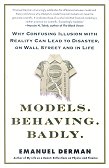Quants, physicists working on Wall Street as quantitative analysts,
have been widely blamed for triggering financial crises with their complex mathematical models.
Their formulas were meant to allow Wall Street to prosper without risk.
But in this penetrating insider’s look at the recent economic collapse,
Emanuel Derman—former head quant at Goldman Sachs—explains the collision between
mathematical modeling and economics and what makes financial models so dangerous.
Though such models imitate the style of physics and employ the language of mathematics,
theories in physics aim for a description of reality—but in finance,
models can shoot only for a very limited approximation of reality.
Derman uses his firsthand experience in financial theory and practice to explain
the complicated tangles that have paralyzed the economy.
Models.Behaving.Badly. exposes Wall Street’s love affair with models,
and shows us why nobody will ever be able to write a model that can encapsulate human behavior.
Essentially, the back cover blurb says it all.
The thesis here is the fundamental difference between theories
(such as occur in the physical sciences)
and models (such as occur in the social sciences, including economics).
p190.
Theories offer us the most successful and accurate way to describe the physical world.
They are deep and difficult to discover; they require verification but no explanation;
they are right when they are right.
Models, however, live in the shallows and are easier to find;
they require explanation as well as verification. We need both types of understanding.
Or, as he says, theories are semantic, models are syntactic.
Syntax alone is not very useful for prediction,
as it captures only surface properties, not the underlying essence.
Another issue with social science models, and particularly financial models,
is that they include the behaviour of people,
who are not always the rational agents they are assumed to be,
and who are trying to second guess each other:
the system is observing and anticipating itself,
which makes predictions by agents within that system somewhat problematical.
If one realises the issues with models, and uses them carefully, then they can indeed be useful.
But Derman argues that many economists do not realise that their models are not theories:
they produce over-simplified models of complex reality,
and over-believe the results.
Even making the models more realistic might not help detailed prediction:
p187.
one gives up simplicity for a still imperfect but more complex model that doesn’t necessarily do better.
As with earthquakes, it may be wiser to remember that catastrophes much more
dramatic than those the random-walk model envisages occur quite often.
It is better to ensure that one owns a portfolio that will not suffer
too badly under disastrous scenarios than it is to try to estimate the
probability of destruction.
Because models are shallow, they provide no help when they fail.
p192.
When models in physics fail, they fail precisely, and often expose a paradox that opens a door.
When models in the social sciences fail, they fail bluntly,
with no hint as to what went wrong and no clue as to what to do next.
With no way forward, people try to restore the status quo ante at any cost.
Rather than calling for better, more detailed models, Derman calls for understanding
the scope and limitations of models.
This is crucially important, and will probably fall on deaf ears.
There is an important message in this book.
However, I found the exposition rather rambling.
The book starts out with a chapter on the author growing up as a Jew in apartheid South Africa.
Then the chapter about theories gives an example of various
ways of naming the God of the Old Testament (which when it wasn’t reminding me of
Lewis Carroll’s White Knight’s discussion
of “the name of the song is called...”,
was making me think “category error”)
and Spinoza’s 17th century analysis of emotions.
All very interesting, possibly, but with what I felt was only the weakest of connections to the main ideas.
